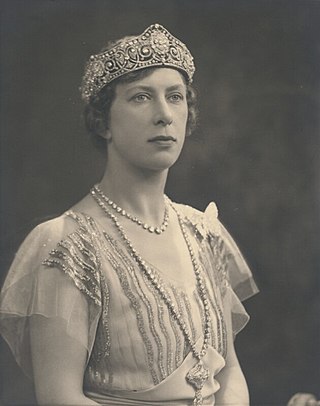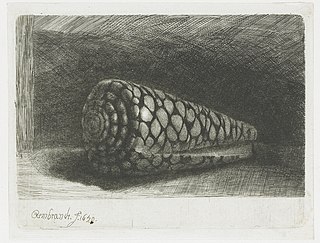
Victoria was Queen of the United Kingdom of Great Britain and Ireland from 20 June 1837 until her death in 1901. Her reign of 63 years and 216 days is known as the Victorian era and was longer than any of her predecessors. It was a period of industrial, political, scientific, and military change within the United Kingdom, and was marked by a great expansion of the British Empire. In 1876, the British Parliament voted to grant her the additional title of Empress of India.

John Brown was a Scottish personal attendant and favourite of Queen Victoria for many years after working as a gillie for Prince Albert. He was appreciated by many for his competence and companionship, and resented by others for his influence and informal manner. The exact nature of his relationship with Victoria was the subject of great speculation by contemporaries.

Thomas Chippendale (1718–1779) was a cabinet-maker in London, designing furniture in the mid-Georgian, English Rococo, and Neoclassical styles. In 1754 he published a book of his designs in a trade catalogue titled The Gentleman and Cabinet Maker's Director—the most important collection of furniture designs published in England to that point which created a mass market for furniture—upon which success he became renowned. According to the Victoria and Albert Museum, "so influential were his designs, in Britain and throughout Europe and America, that 'Chippendale' became a shorthand description for any furniture similar to his Director designs".

Mary, Princess Royal and Countess of Harewood, was a member of the British royal family. She was the only daughter of King George V and Queen Mary, the sister of kings Edward VIII and George VI, and aunt of Elizabeth II. In the First World War, she performed charity work in support of servicemen and their families. She married Henry Lascelles, Viscount Lascelles, in 1922. Mary was given the title of Princess Royal in 1932. During the Second World War, she was Controller Commandant of the Auxiliary Territorial Service. The Princess Royal and the Earl of Harewood had two sons, George Lascelles, 7th Earl of Harewood, and The Honourable Gerald Lascelles.

The Penny Red was a British postage stamp, issued in 1841. It succeeded the Penny Black and continued as the main type of postage stamp in the United Kingdom of Great Britain and Ireland until 1879, with only minor changes to the design during that time. The colour was changed from black to red because of difficulty in seeing a cancellation mark on the Penny Black; a black cancellation mark was readily visible on a Penny Red.

The Prince Consort Essay was a surface printed printer's sample stamp created in 1851 as an example of the surface printed stamps that Henry Archer proposed to print and perforate under contract with the British government at a lower price than the current printing firm of Perkins Bacon. The Prince Consort stamps were provided by the artist Robert Edward Branston, from an engraving executed by Samuel William Reynolds.

George Washington Wilson was a pioneering Scottish photographer. In 1849, he began a career as a portrait miniaturist, switching to portrait photography in 1852. He received a contract to photograph the Royal Family, working for Queen Victoria and Prince Albert. He pioneered various techniques for outdoor photography and the mass production of photographic prints as he gradually began to largely do landscape photography in the 1860s. By 1864 he claimed to have sold over half a million copies.

Sir George Hayter was an English painter, specialising in portraits and large works involving in some cases several hundred individual portraits. Queen Victoria appreciated his merits and appointed Hayter her Principal Painter in Ordinary and also awarded him a Knighthood 1841.

Sir Francis Job Short PPRE was a British printmaker and teacher of printmaking. He revived the practices of mezzotint and pure aquatint, while expanding the expressive power of line in drypoint, etching and engraving. Short also wrote about printmaking to educate a wider public and was President of the Royal Society of Painter Etcher & Engavers from 1910 to 1938. He was a member of the Art Workers' Guild and was elected Master in 1901.

The Birds of America is a book by naturalist and painter John James Audubon, containing illustrations of a wide variety of birds of the United States. It was first published as a series in sections between 1827 and 1838, in Edinburgh and London. Not all of the specimens illustrated in the work were collected by Audubon himself; some were sent to him by John Kirk Townsend, who had collected them on Nathaniel Jarvis Wyeth's 1834 expedition with Thomas Nuttall.

George Edward Anson was a British courtier and politician from the Anson family.
Breach of confidence in English law is an equitable doctrine that allows a person to claim a remedy when their confidence has been breached. A duty of confidence arises when confidential information comes to the knowledge of a person in circumstances in which it would be unfair if it were disclosed to others. Breach of confidence gives rise to a civil claim. The Human Rights Act 1998 has developed the law on breach of confidence so that it now applies to private bodies as well as public ones.

St George's Chapel at Windsor Castle in England is a castle chapel built in the late-medieval Perpendicular Gothic style. It is a Royal Peculiar, and the Chapel of the Order of the Garter. St George's Chapel was founded in the 14th century by King Edward III and extensively enlarged in the late 15th century. It is located in the Lower Ward of the castle.
Thomas Worlidge (1700−1766) was an English painter and etcher.

Queen Victoria maintained diaries and journals throughout her life, filling 122 volumes which were expurgated after her death by her daughter Princess Beatrice. Extracts were published during her life and sold well. The collection is stored in the Royal Archives and, in 2012, was put online in partnership with the Bodleian Libraries.

The state funeral of Victoria, Queen of the United Kingdom of Great Britain and Ireland, Empress of India, occurred on 2 February 1901, after her death on 22 January. It was one of the largest gatherings of European royalty.
Constance Mary Pott, RE, was an English printmaker and teacher active during the late nineteenth century and the twentieth century. She became technical and teaching assistant to the teacher and printmaker Sir Frank Short at the Royal College of Art from 1902 until Short's retirement in 1924. In her day she was recognized as a pioneer in the etching revival, for her dynamic, versatile mastery of technique and line, for the spacious evocation of landscape in her plates, and for her formal professional occupation, all exceptional achievements by any standards, but more especially so in their combining in her to overcome societal disapproval of professions for women. As a teacher she had a powerful and acknowledged influence upon a whole generation of engravers who passed through the College. However, she long outlived the fashion of that movement, and her central role in it was for a time almost forgotten. Examples of her own works, principally etchings, are held in leading national collections, and appear in the salerooms. She is sometimes confused with her mother, Constance Mary née Fearon, Mrs Henry Pott (1833-1915).

The Shell, also known as Rembrandt's Shell or Conus Marmoreus, or in Dutch as De schelp or Het schelpje, is a 1650 drypoint and etching by Rembrandt van Rijn. Catalogued as B.159, it is Rembrandt's only still life etching. Only a handful of original prints are known, in three states.
Delia Mary, Lady Millar C.V.O., was the wife of the British art historian and Surveyor of the Queen’s Pictures, Sir Oliver Nicholas Millar and an art historian in her own right. A specialist in the art of the Victorian era, she was appointed Commander of the Royal Victorian Order in recognition of her services to the Royal Collection.

Queen Victoria is an oil on canvas painting by German artist Franz Xaver Winterhalter, created in 1843. It depicts British Queen Victoria in her young years, at the beginning of her long reign. The work is part of the Royal Collection.

















